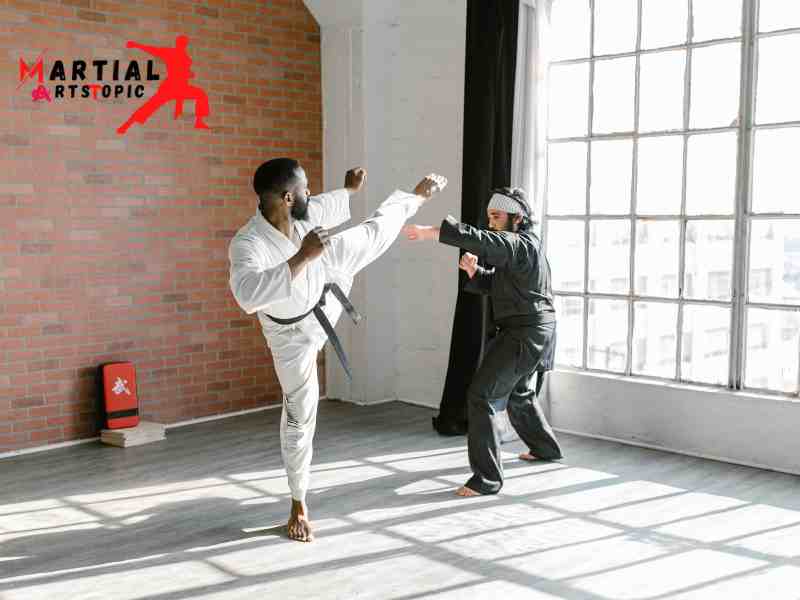
The Art of Shotokan Karate: A Beginner’s Guide
What is Shotokan Karate? The Art of Shotokan Karate: A Beginner’s Guide Are you interested in learning the ancient and powerful martial art of Shotokan Karate? Look no further! In this comprehensive beginner’s guide, we will dive into the world of Shotokan Karate, exploring its history, key principles, techniques, and benefits. Whether you are a fitness enthusiast, someone seeking self-defense skills, or simply intrigued by the art of Karate, this guide is for you.
Shotokan Karate, also known as Japanese Karate, is one of the most widely practiced styles of Karate in the world. Founded by Gichin Funakoshi in the early 20th century, Shotokan Karate emphasizes discipline, focus, and the development of physical and mental strength. It is a perfect blend of tradition, philosophy, and self-defense techniques.
The key principles of Shotokan Karate revolve around pursuiting perfection through rigorous training, respect for oneself and others, and the cultivation of a strong character. Shotokan Karate practitioners strive to achieve a balance in mind, body, and spirit. The foundation of Shotokan Karate lies in the practice of kata, which are choreographed patterns of movements that simulate combat scenarios.
One of the distinguishing features of Shotokan Karate is its emphasis on strong, dynamic techniques. Practitioners learn a wide range of strikes, kicks, blocks, and stances that are not only effective in self-defense but also contribute to overall physical fitness. Shotokan Karate training involves both solo practice and partner drills, ensuring that students develop both the technical skills and the ability to apply them in real-life situations.
Apart from the physical benefits, practicing Shotokan Karate offers many mental and emotional advantages. Regular training helps improve focus, concentration, and discipline. It teaches practitioners to remain calm and composed under pressure, enhancing their self-confidence and self-control. Shotokan Karate also provides an avenue for stress relief and self-expression, allowing individuals to channel their energy positively.
If you’re ready to embark on your journey into the world of Shotokan Karate, finding a reputable dojo (training center) is crucial. Look for a certified instructor who has extensive experience and a solid understanding of the principles and techniques of Shotokan Karate. A good instructor will ensure proper form, technique, and safety during training sessions, while also offering guidance and support to help you achieve your goals.
As a beginner, it is important to start with the basics and gradually progress to more advanced techniques. Remember that learning Shotokan Karate is a continuous process that requires patience, perseverance, and dedication. Regular practice is key to mastering the art and reaping its benefits. It is also essential to listen to your body, avoid overexertion, and follow the guidance of your instructor to prevent injuries.
What is Shotokan Karate?
What is Shotokan Karate? Shotokan Karate is a traditional Japanese martial art developed by Gichin Funakoshi. Its powerful, linear techniques and emphasis characterize it on kata (forms) and kumite (sparring). Shotokan practitioners focus on developing speed, strength, and precision in their movements, as well as mental discipline and focus. The art prioritizes self-improvement and personal growth through rigorous training and adherence to the dojo kun (training hall rules). Shotokan Karate is widely practiced around the world and is known for its emphasis on kihon (basic techniques), kata, and kumite as integral components of training. If you’re looking to improve your physical fitness, mental discipline, and self-defense skills, Shotokan Karate offers a rich and rewarding path to personal development.
History of Shotokan Karate Origins and development
Shotokan Karate: Exploring the Origins and Development Shotokan Karate is one of the most popular and influential styles of martial arts in the world. Known for its powerful strikes and dynamic movements, Shotokan Karate has a rich history that dates back to the early 20th century. In this blog post, we will delve into the origins and development of Shotokan Karate, shedding light on the key figures and events that have shaped this iconic martial art.
Origins of Shotokan Karate
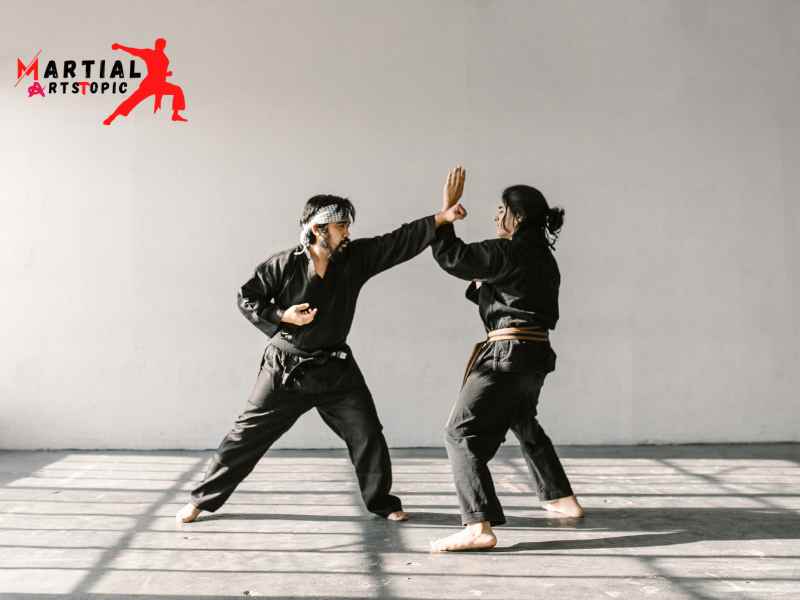
Shotokan Karate traces its roots back to the island of Okinawa, a small island in Japan. During the 17th century, Okinawa was a hub for trade between China and Japan, resulting in the exchange of various cultural practices, including martial arts. It was during this time that the indigenous martial arts of Okinawa, known as Te, developed.
We can attribute the development of Shotokan Karate to the efforts of Gichin Funakoshi. Born in Okinawa in 1868, it exposed Funakoshi to martial arts from a young age. He studied under various masters, including Yasutsune Itosu, who played a pivotal role in promoting the practice of Te in Okinawa.
In 1922, Funakoshi traveled to Tokyo to show his martial art at the First National Athletic Exhibition. This was a significant turning point for Shotokan Karate, as it gained recognition and acceptance on a national level. Funakoshi’s demonstration captivated the audience, and they subsequently invited him to stay in Tokyo to teach karate.
Development of Shotokan Karate
Under Funakoshi’s tutelage, Shotokan Karate continued to develop and gain popularity. Funakoshi emphasized the importance of character development and self-discipline alongside physical training. He believed that karate was not just a means of self-defense but also a path to self-improvement.
In 1939, Funakoshi established the Japan Karate Association (JKA) to further promote and develop Shotokan Karate. The JKA became the largest and most influential Karate organization in Japan, spreading the practice of Shotokan Karate both nationally and internationally.
Following Funakoshi’s passing in 1957, his son, Yoshitaka Funakoshi, took up the mantle and continued his father’s legacy. Yoshitaka played a crucial role in refining and modernizing Shotokan Karate, introducing new training methods and techniques.
Shotokan Karate Today
Today, millions of people practiced Shotokan Karate worldwide. We can see its influence in various martial arts disciplines and even in popular culture. The powerful techniques, disciplined training, and philosophical teachings of Shotokan Karate continue to inspire and empower practitioners of all ages and backgrounds.
The International Shotokan Karate Federation (ISKF) is one of the leading organizations dedicated to preserving and promoting Shotokan Karate. With branches in many countries, the ISKF provides training, certification, and opportunities for practitioners to compete at national and international levels.
The Philosophy of Shotokan Karate: The Roots of a Martial Art
Shotokan Karate traces its roots to the island nation of Japan, where it was developed in the early 20th century. Gichin Funakoshi, the revered founder of Shotokan Karate, first introduced this martial art to the world. Funakoshi’s vision was to promote physical and mental well-being through the practice of Karate.
Philosophy of Shotokan Karate
At the heart of Shotokan Karate lies a profound philosophy that extends beyond physical combat. Shotokan emphasizes the development of character, self-discipline, and respect. It aims to cultivate a sense of inner strength, harmony, and humility among its practitioners.
Kihon, Kata, and Kumite
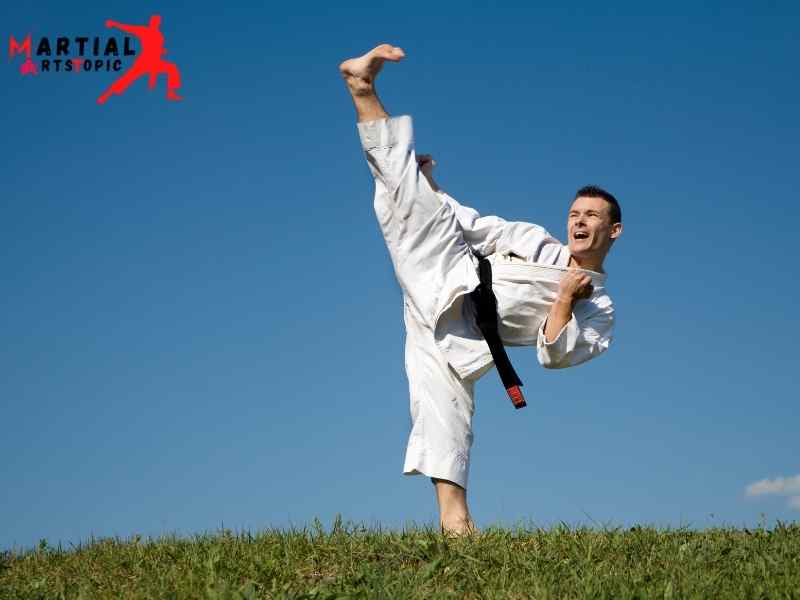
They structure shotokan Karate around three primary aspects: Kihon (fundamental techniques), Kata (forms), and Kumite (sparring). Kihon involves mastering stances, strikes, kicks, and blocks, forming the foundation for all other aspects of the art. Kata are pre-arranged sequences of movements that simulate real-life combat scenarios, allowing practitioners to practice techniques and develop muscle memory. Kumite, the dynamic sparring element, enables practitioners to apply their skills in a controlled environment.
Five Principles of Shotokan Karate
Five principles, known as the Dojo Kun guide shotokan Karate. These principles serve as a code of conduct, emphasizing moral values and personal growth. They are:
- Seek perfection of character: Encourages practitioners to continuously strive for self-improvement and personal growth.
- Be faithful: Promotes loyalty, trustworthiness, and integrity within the martial arts community.
- Endeavor to excel: Encourages practitioners to push their boundaries, setting and achieving goals both on and off the mat.
- Respect others: Emphasize the importance of respect, humility, and empathy towards fellow practitioners and opponents.
- Refrain from violent behavior: Advocates the responsible and ethical use of martial arts skills, promoting peace and harmony.
Global Impact and Modern Evolution
Shotokan Karate’s influence has spanned across the globe, with millions of practitioners and many associations dedicated to its preservation. It has been adopted as the foundation for many other styles of Karate and has become an Olympic sport, further establishing its global presence.
Over the years, Shotokan Karate has evolved, incorporating modern training methods while preserving its traditional essence. Continuous research and development has resulted in a deeper understanding of its techniques and principles, ensuring its longevity as a respected martial art.
Techniques and Training in Shotokan Karate
Shotokan Karate: Techniques and Training for Martial Arts Enthusiasts Shotokan Karate, a traditional form of Japanese martial art, has gained immense popularity worldwide because of its dynamic techniques, powerful strikes, and disciplined training methods. Whether you are a beginner looking to start your martial arts journey or a seasoned practitioner aiming to refine your skills, understanding the techniques and training principles of Shotokan Karate is essential. In this blog post, we will delve into the world of Shotokan Karate, exploring its key elements and providing insights into effective training methods.
Karate Basics: The Fundamentals of Shotokan Karate
Shotokan Karate emphasizes firm stances, powerful strikes, and efficient movement. The basics of Shotokan Karate include:
- Kihon (Basics): This involves practicing fundamental techniques such as punches (tsuki), kicks (geri), and blocks (uke) repetitively. Focusing on proper form, balance, and precision helps develop muscle memory and fundamental skills.
- Kata (Forms): Kata is a series of choreographed movements, simulating combat scenarios against imaginary opponents. Practicing kata enhances fluidity, timing, and mental focus while incorporating various techniques.
- Kumite (Sparring): Kumite allows practitioners to apply their techniques in a controlled sparring environment. It promotes the development of timing, distance control, and the ability to react quickly to an opponent’s movements.
Shotokan Karate Techniques: Mastering the Art of Striking
Shotokan Karate is renowned for its powerful and precise striking techniques. Here are some key techniques commonly practiced in Shotokan Karate:
- Oi-Zuki (Stepping Punch): A straightforward lunge punch, executed with speed and power, targeting the opponent’s midsection or head.
- Mae-Geri (Front Kick): A front kick delivered with the ball of the foot, aimed at the opponent’s midsection or face.
- Shuto-Uchi (Knife Hand Strike): A strike using the side of the hand, typically targeting vulnerable areas such as the neck, temple, or collarbone.
- Mawashi-Geri (Roundhouse Kick): A circular kick delivered with the ball of the foot, targeting the opponent’s torso or head.
Training Methods for Shotokan Karate: Building Strength and Discipline
To excel in Shotokan Karate, a well-rounded training routine is crucial. Here are effective training methods to consider:
- Strength and Conditioning: Incorporate exercises such as push-ups, sit-ups, squats, and lunges to build overall strength and endurance. Practicing kata and kumite drills enhances cardiovascular fitness and muscular endurance.
- Flexibility Training: Stretching exercises like splits, leg raises, and hip rotations improve flexibility, allowing for more effective kicks and evasive movements.
- Focus on Kime: Kime refers to the moment of maximum power and focus on each technique. Practicing kime ensures that they deliver your strikes with maximum impact and precision.
- Mental Discipline: Shotokan Karate emphasizes mental fortitude and discipline. Meditation, visualization, and breathing exercises help cultivate focus, concentration, and a calm mind during training and combat situations.
Training Dojo: The Karate Community
They often conduct Shotokan Karate training in a dojo, a dedicated space for martial arts practice. The dojo fosters a sense of community, camaraderie, and respect among practitioners. Under the guidance of experienced instructors, karateka learns from one another, support each other’s growth, and upholds the principles of Shotokan Karate.
Basic Techniques in Shotokan Karate
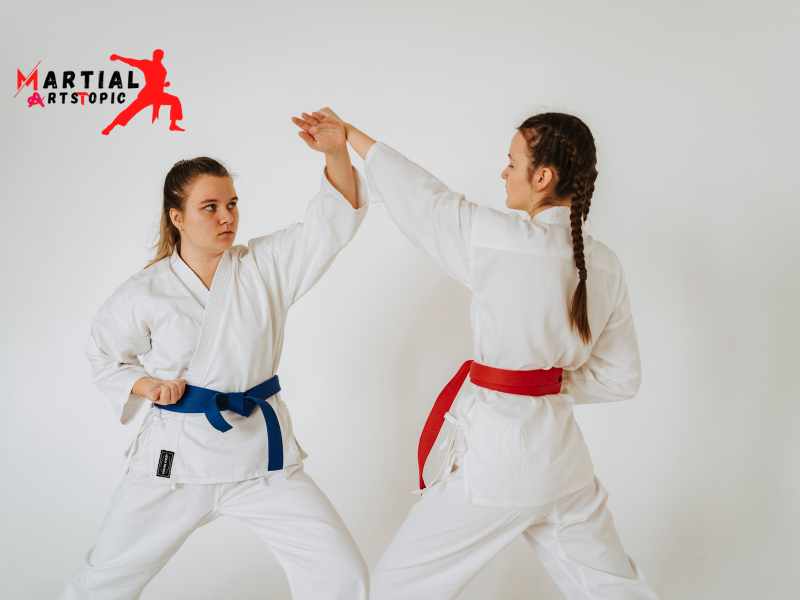
What is Shotokan Karate? Shotokan Karate: The Basic Techniques Shotokan Karate is a traditional martial art that originated in Japan. We know it for its powerful strikes, strong stances, and emphasis on discipline and self-improvement. In this blog post, we will delve into the basic techniques of Shotokan Karate and how they form the foundation of this revered martial art.
- Punches (Zuki): One of the fundamental techniques in Shotokan Karate is the punch. Executed with precision and power, punches are used to strike targets with the fist. Whether it’s the straightforward punch (choku zuki), uppercut (age zuki), or hook punch (kagi zuki), mastering these techniques requires proper alignment, correct timing, and a strong core.
- Kicks (Geri): Kicks is another essential aspect of Shotokan Karate. From the front kick (mae geri) to the roundhouse kick (mawashi geri), these techniques involve flexibility and coordination. Kicks are not only effective for striking opponents, but also for maintaining distance and creating opportunities for counterattacks.
- Blocks (Uke): Shotokan Karate places great emphasis on defensive techniques, and blocks play a crucial role in this aspect. Blocks are used to intercept and redirect an opponent’s attack, minimizing the impact and creating an opening for counterattacking. Some common blocks in Shotokan Karate include the rising block (age uke), outward block (soto uke), and inward block (uchi uke).
- Stances (Dachi): Stances are the foundation of stability and power in Shotokan Karate. Proper stances help maintain balance and generate maximum force in techniques. The most common stances include the front stance (zenkutsu dachi), back stance (kokutsu dachi), and horse stance (kiba dachi).
- Strikes (Uchi): Shotokan Karate incorporates various strikes, such as knife-hand strikes (shuto uchi), hammer fist strikes (tettsui uchi), and elbow strikes (hiji uchi). They execute these techniques with speed and precision to exploit an opponent’s vulnerabilities.
- Kata: Kata refers to a predetermined sequence of movements that simulates a fight against multiple opponents. Practicing kata helps improve technique, timing, and mental focus. Shotokan Karate has a set of specific kata, including Heian Shodan, Bassai Dai, and Kanku Dai, each with its own unique challenges and lessons.
- Kumite: Kumite, or sparring, is an integral part of Shotokan Karate training. It allows practitioners to apply techniques in a controlled environment against a live opponent. Kumite builds reflexes, timing, and adaptability, preparing students for real-life self-defense situations.
Kiai:Kiai, the loud shout, is a distinctive feature of Shotokan Karate. It is used to focus energy, intimidate opponents, and enhance overall performance. Proper execution of kiai requires correct breathing techniques and mental concentration.
Shotokan Karate is a journey of constant learning and self-discovery. By mastering the basic techniques, practitioners develop physical strength, mental discipline, and self-confidence. It is important to remember that practice, dedication, and guidance from a qualified instructor are key to progressing in this martial art.
Benefits of Practicing Shotokan Karate
Shotokan Karate is a traditional Japanese martial art that has gained immense popularity worldwide. With its roots deeply embedded in self-discipline, physical fitness, and mental well-being, practicing Shotokan Karate offers a wide range of benefits. In this blog post, we will explore some of the key advantages that individuals can gain from this ancient martial art.1. Improved Physical Fitness: Shotokan Karate is a highly physical activity that engages every muscle group in the body. By practicing various techniques, such as punches, kicks, and blocks, practitioners can enhance their cardiovascular endurance, strength, flexibility, and overall physical fitness. Regular training sessions help individuals develop strong, lean muscles and improve their coordination and balance.
- Self-Defense Skills: Shotokan Karate is renowned for its effective self-defense techniques. By practicing this martial art, individuals learn how to protect themselves in real-life situations. Shotokan Karate emphasizes quick and powerful strikes, precise footwork, and strategic movements, enabling practitioners to defend themselves against potential threats. The confidence gained from knowing self-defense techniques can help individuals feel safer and more secure in their daily lives.
- Mental Focus and Discipline: Shotokan Karate places a strong emphasis on mental discipline and focus. Practitioners are required to concentrate deeply on their movements, breathing, and techniques, which improve their ability to focus and maintain mental clarity. This sharpened focus carries over into other aspects of life, enabling individuals to remain focused and achieve their goals, be it in academics, careers, or personal endeavors.
- Stress Relief: The practice of Shotokan Karate can serve as an effective stress reliever. The focused movements and intense physical activity help release endorphins, which boost mood and reduce stress levels. The traditional dojo environment, with its emphasis on respect, camaraderie, and support, provides a supportive community that allows practitioners to unwind and find solace from the pressures of everyday life.
- Boosted Confidence and Self-Esteem: Shotokan Karate instills a sense of confidence and self-esteem in practitioners. As individuals progress through the ranks and master new techniques, they gain a sense of accomplishment and pride. The discipline and perseverance required in Shotokan Karate training build resilience and the belief in one’s abilities, leading to increased self-confidence and a positive self-image.
- Improved Focus and Concentration: Shotokan Karate requires practitioners to focus their attention on each movement, technique, and combination. This practice enhances focus and concentration skills, which can be beneficial in all aspects of life. Whether it’s studying for exams, completing work assignments, or engaging in daily tasks, improved focus and concentration lead to increased productivity and efficiency.
- Character Development: Shotokan Karate is not just about physical techniques; it also places great importance of character development. Through the practice of respect, discipline, and humility, individuals learn valuable life lessons that can be applied both on and off the mat. Shotokan Karate promotes values such as perseverance, integrity, and self-control, which contribute to the development of well-rounded individuals.
The Mental Benefits of Practicing Shotokan Karate: How it Enhances Focus and Discipline
The Mental Benefits of Practicing Shotokan Karate: How it Enhances Focus and Discipline Shotokan Karate is not just a physical activity; it is a practice that offers a wide range of mental benefits. While the physical aspect of this martial art is well known, its impact on mental health and well-being often goes unnoticed. In this blog post, we will explore the mental benefits of practicing Shotokan Karate and how it enhances focus and discipline.
Improved Focus:
One of the key mental benefits of Shotokan Karate is its ability to improve focus. During training sessions, they encourage practitioners to concentrate on their movements, breathing, and techniques. This focused attention helps develop a sharp and clear mind, which can apply to other areas of life as well. Whether it’s at work, school, or any other activity, the enhanced focus gained through Shotokan Karate can positively affect your performance.
Increased Discipline
Shotokan Karate requires discipline, both in terms of physical training and mental control. Practitioners have to adhere to a strict code of conduct, which promotes self-discipline and self-control. The repetitive nature of training in Shotokan Karate helps individuals develop the discipline to consistently practice and improve their skills. They can then transfer this discipline to other aspects of life, such as work ethic, time management, and goal-setting.
Stress Relief
Engaging in Shotokan Karate can be a great way to relieve stress and improve mental well-being. The physical exertion and focus required during training sessions helps release endorphins, which are natural mood boosters. The practice of Shotokan Karate involves controlled breathing techniques, which can induce a state of relaxation and calmness. Regular practice can help individuals better manage stress and maintain a positive mindset.
Increased Confidence
Shotokan Karate provides individuals with a sense of accomplishment and self-confidence. As practitioners progress through the ranks and master new techniques, they gain a strong belief in their abilities. This newfound confidence spills over into other areas of life, making individuals more assertive and self-assured. The mental strength developed through Shotokan Karate empowers individuals to face challenges with courage and determination.
Mental Resilience
Shotokan Karate teaches individuals to push their limits, both physically and mentally. The training involves facing and overcoming various challenges, which build mental resilience. Practitioners learn to embrace failure as an opportunity for growth and develop a never-give-up attitude. We can apply this mental resilience cultivated through Shotokan Karate to all areas of life, helping individuals bounce back from setbacks and face adversity with resilience.
Kumite: The Essential Sparring Techniques in Shotokan Karate
Kumite: The Essential Sparring Techniques in Shotokan Karate Are you ready to take your Shotokan Karate skills to the next level? Look no further than mastering Kumite, the art of sparring. Kumite is a fundamental aspect of Shotokan Karate, allowing practitioners to apply their techniques in a dynamic and realistic environment. In this blog post, we will explore the essential sparring techniques in Shotokan Karate that will help you become a formidable Kumite practitioner.
Ippon Kumite (One-step Sparring)
Ippon Kumite is a foundational sparring technique that emphasizes precise timing, distance, and control. In this exercise, one practitioner starts an attack, while the other responds with a pre-determined technique. The key here is to focus on executing techniques with speed and accuracy, while maintaining a strong stance and balance.
Jiyu Kumite (Free Sparring)
Jiyu Kumite is the ultimate test of a Shotokan Karateka’s skill and adaptability. In this form of sparring, practitioners engage in an unpredictable exchange of techniques, simulating real-life combat situations. It requires quick reflexes, effective footwork, and the ability to expect and counter your opponent’s moves. Jiyu Kumite builds confidence, enhances reaction time, and sharpens decision-making skills.
Sanbon Kumite (Three-step Sparring)
Sanbon Kumite is an intermediate level sparring technique that focuses on building coordination and timing. It involves a series of three attacks and counterattacks, performed in a controlled manner. This exercise helps practitioners develop a sense of rhythm and teaches them to transition seamlessly between offense and defense.
Kihon Ippon Kumite (Basic One-step Sparring)
Kihon Ippon Kumite is a simplified version of Ippon Kumite, designed for beginners to practice fundamental techniques in a controlled environment. It helps develop proper form, focus, and timing, providing a solid foundation for Kumite training.
Gohon Kumite (Five-step Sparring)
Gohon Kumite is an advanced sparring technique that involves a series of five attacks and counterattacks. It trains practitioners to think and react quickly, as they perform a combination of offensive and defensive moves in rapid succession. Gohon Kumite enhances fluidity of movement, builds endurance, and hones the ability to adapt to different scenarios.
Ohyo Kumite (Applied Sparring)
Ohyo Kumite focuses on applying techniques learned in Kata (forms) to real-life combat situations. It emphasizes practical self-defense techniques and helps practitioners understand the principles and applications of Shotokan Karate techniques in a realistic context.
By practicing these essential sparring techniques in Shotokan Karate, you will develop crucial skills that will enhance your overall martial arts abilities. Remember, mastering Kumite requires dedication, discipline, and consistent practice. So, keep training, stay focused, and embrace the spirit of Shotokan Karate!
The Benefits of Shotokan Karate for Physical and Mental Health
Shotokan Karate, a traditional Japanese martial art, offers a wide range of benefits for both physical and mental health. Engaging in regular practice of Shotokan Karate can improve cardiovascular fitness, enhance flexibility, and increase overall strength. The dynamic movements and rigorous training involved in Shotokan Karate not only help individuals build physical endurance but also promote mental focus and discipline. The practice of Shotokan Karate involves intense concentration, which can help reduce stress and improve cognitive function. The structured nature of the training and the sense of community fostered in Shotokan Karate classes can contribute to improved self-confidence and self-esteem. Explore the many advantages that Shotokan Karate offers for your well-being.
Shotokan Karate for Self-Defense: Empowering Techniques and Strategies
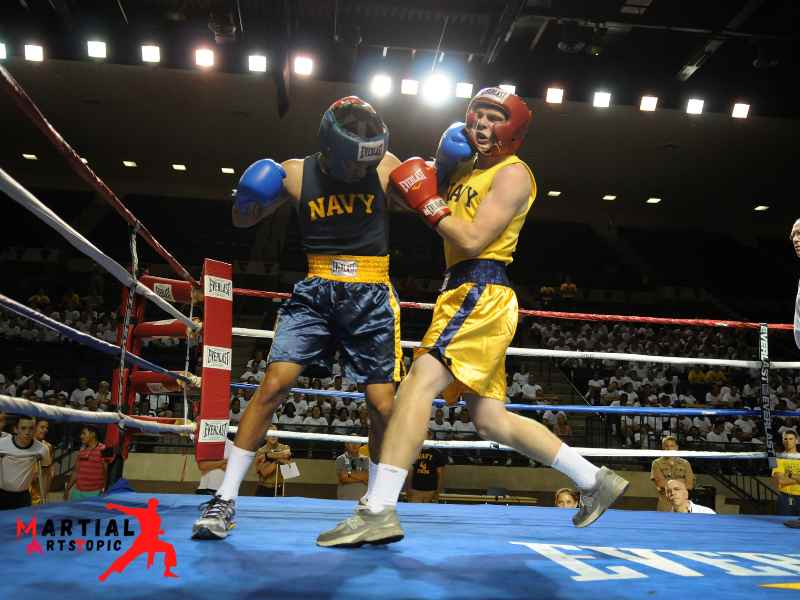
Shotokan Karate for Self-Defense: Empowering Techniques and Strategies for self-defense, it’s crucial to have the right techniques and strategies in your arsenal. One martial art that is renowned for its effectiveness in self-defense is Shotokan Karate. Shotokan Karate is a traditional Japanese martial art that focuses on powerful strikes, dynamic movements, and efficient techniques. In this blog post, we will explore the empowering techniques and strategies of Shotokan Karate, and how they can help you in real-life self-defense situations.
One of the key aspects of Shotokan Karate is its emphasis on strong and precise striking techniques. They trained practitioners of Shotokan Karate to deliver powerful punches, kicks, and strikes with maximum impact. These techniques are not only effective for self-defense, but they also help to build strength, speed, and coordination. By mastering the art of striking, you can effectively defend yourself and neutralize any potential threats.
Another important aspect of Shotokan Karate is its focus on dynamic movements. They trained shotokan Karate practitioners to move quickly and fluidly, enabling them to evade and counteract attacks effectively. This agility and flexibility are essential in self-defense situations, as they allow you to quickly assess and respond to any threat that comes your way. By practicing Shotokan Karate, you can develop the ability to move with precision and grace, giving you a significant advantage in any self-defense scenario.
Besides striking and dynamic movements, Shotokan Karate also places a strong emphasis on efficient techniques. We designed shotokan Karate techniques to be effective, with an emphasis on simplicity and directness. This focus on efficiency means that you can quickly and effectively neutralize an attacker without wasting unnecessary energy or time. By training in Shotokan Karate, you will learn to use techniques that are specifically designed for real-life self-defense situations, giving you the confidence and skills necessary to protect yourself and others.
Shotokan Karate also incorporates mental aspects into its training. It taught practitioners discipline, focus, and self-control, which are crucial qualities in self-defense. By developing a strong mindset and remaining calm under pressure, you can effectively assess and respond to dangerous situations. Shotokan Karate not only empowers you physically but also mentally, allowing you to make sound decisions and take actions when faced with potential threats.
